This is Episode 200!! Yeeeey, wooh!
It’s been almost 4 years now since I started the Martin Bailey Photography Podcast and today marks the 200th episode. I almost can’t believe it. Bear with me as I revel in this for a few minutes, but I want to talk just a little while today before we get into the main topic, and look at some of my shots from a recent trip to the Oirase Mountain Stream in Aomori, Japan.
In the 100th episode, I said that I had no intention of stopping, but believe me, getting to 200 episodes was a lot harder than getting to 100. People sometimes say that they don’t know how I find the time to do what I do, and to be honest, neither do I sometimes! It’s not always obvious, as I keep the two separate, but I do still have a full time, non-photography related day job. Not only does that keep me very busy, we also moved offices at the end of 2007, so I lost an extra hour or so a day to a longer commute, and it has sometimes been a struggle to make time to prepare each week, and to get myself in front of the computer to record. I’ve done a few things to make life easier for myself, and although I’m now much more active in social networking, like Twitter and Flickr, I’m kind of in the swing of things now, and have even started blogging, releasing show notes and trying to blog at least once more each week on something photography related that caught my attention. Keeping busy, but right now, enjoying it.
I actually received a great congratulations message from Listener and community member David Peacham, based in Perth, Australia. David kindly agreed to let me read his message out here, so here goes. David wrote;
Hi Martin,
I just wanted to congratulate you on the fantastic achievement of reaching 200 podcasts. I’m sure it has been at times difficult to continue the schedule of one a week and to maintain and improve on the quality of the podcasts over the months and years. I’d like to tell you how much I enjoy the podcasts and look forward to each new episode and to let you know how much I truly appreciate all your efforts.
Your work truly inspires me and many others as evidence of the growth we can see in the forum, in your website and the success of your workshops. The blog is a great new feature. I wish you every success in the future and I will stay tuned to my favourite photographer.
I am working on a five year goal that I will be on the Martin Bailey photography workshop in 2014 so that I can thank you in person for the wonderful work that you do that has changed my life.
Many congratulations,
David Peacham.
I’d also like to share part of my reply to David, as follows;
It has been tough doing the Podcast for 200 episodes, but I do get a lot back from this as well. Not only does the very action of creating the Podcast each week help to keep me in check and help to improve my own photography, it’s a huge honour to influence peoples’ lives, and to inspire people in any way. Getting confirmation that I am achieving that means so much to me.
——–
From time to time I receive wonderful messages like this, and probably should read them out much more than I do, but I do want to say a huge thanks to David and each and every one of you that has written similar messages. I really do appreciate it. Without all of you that make up the community that has built around this Podcast none of it would mean a thing of course, so thanks everyone that listens and has encouraged me to keep going over the last four years.
While on the subject of thanks I would like to say a huge thank you to our sponsors, WebSpy, the Internet Monitoring, Analysis & Reporting Specialists. There are a lot of costs involved in keeping this Podcast going, so it really does help to have such a great company as WebSpy sponsoring us now. To find out more about WebSpy and their products, go to webspy.com/mbp, and use the discount code MBPWSY for a 10% discount on all purchases.
Now let’s finally jump into the main topic, and see some shots from Oirase.
Main Topic:
In Episode 46, I discussed a number of images that I’d shot in a place called Oirase, which is basically a mountain stream in the Aomori Prefecture at the very top of mainland Japan. That was way back in July 2006. I recently planned a trip back there, because I wanted to take a copy of the book that I recently received to the old gentlemen that had allowed me to photograph him for two days, as he gathered urushi, which is the sap from his laquer trees. This was an assignment that I did for the book and as the book was finally completed and arrived a few weeks ago, I decided to take the opportunity to go to Aomori, and having handed him his copy personally, I drove on for another 30 miles or so to Oirase, which is just a beautiful place.
So, let’s look at the first image, which is image number 2298 (below) in my online gallery at martinbaileyphotography.com. If you are listening to this Podcast in iTunes or an iPod or iPhone, you will be able to see this image, and the other images we talk about as we progress. If not, you can type in the number I call out into the Podcasts menu or look at the images on the blog or my Podcasts page.
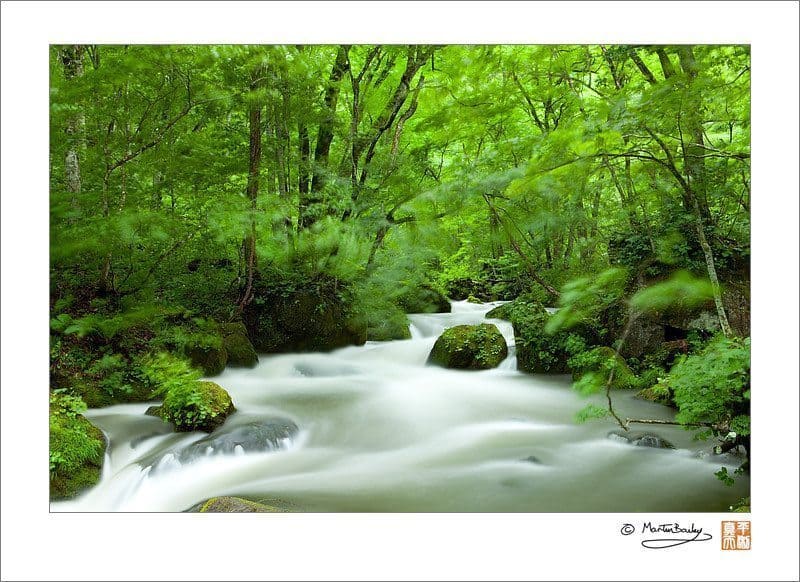
Oirase Mountain Stream
In this first image, you can see the main reason I had visited Oirase at this time. I actually realized after I’d planned the trip that I was going to be there on July the 10th, which was exactly the same day that I had visited three years before. The time of year is no coincidence though, as I this beautiful fresh green is at its best right now. We have a rainy season in Japan for about six weeks from June to late July, and I try to get here right at the tail end of that rainy season with all the new leaves, and lots of water in the mountain stream. There had been a lot of rain in the days running up to my visit, and it was still raining on and off on my first afternoon here. It’s the rain also that makes these greens so (pardon the pun) saturated color-wise. A number of people have commented on the greens in my images, and to be honest, I’m not quite sure what makes them so special, but I will tell you a few things that I pay attention to here, in the hope that it helps.
The first thing is to try to photograph greenery like this when the foliage is wet. I also try to shoot when it’s overcast. If it’s still raining, that’s usually not a problem. We’ll look at another image later where the sun did come out a little. Even then I waited for it to be at its weakest before releasing the shutter, but you can really see the difference. I usually select the Daylight preset White Balance, as I don’t like the camera changing its mind every shot as the scene changes. I don’t select the cloudy preset, because I don’t want the scene falsely warmed up either. I don’t do custom white balance either, as this tends to warm up the greens too much for my liking as well. As is often the case, I expose for the highlights, which means that I set my exposure to the highest it can be without the highlights clipping. I adjust the exposure until I see the little flashing warnings on the LCD, or until any of the channels in the RGB histogram get too close to the right shoulder. If direct sunlight hits the water the contrast gets too high, and I end up having to shoot the greens darker to stop the water from blowing out. That also stops the greens looking so lush.
This particular shot was made with ISO 100 at F11 for 15 seconds. Of course to get that slow a shutter speed, I was using a three stop ND8 neutral density filter. It was actually pretty dark with it being overcast, so I could get down slow enough to make the water look nice and flowing, but as my tastes change, I find that I want a more dreamy look. I think I said a few years ago that you don’t want to go too slow, or it looks overdone. Now I actually prefer what I used to think is overdone, so it just goes to show how we change.
Anyway, we have another seven images to get through, so I’m going to try to pick up the pace a little here. Next up is image number 2303 (below). This is the Choushi Ootaki. Choushi is a small bottle, like a kind of decanter for Japanese Sake, and it’s said that these falls are like the flow of liquid from the bottle when it gets tipped over. Ootaki is used a lot for big waterfalls like this, because it simply means Big Falls. These are beautiful falls, with lots of mist thrown up from the water. Because of this I continuously checked the front element of my lens for droplets of water. I had to wipe it off a number of times, to make sure I didn’t get any little blurred spots on the image, caused by the droplets. You’ll also notice that I sometimes have moving leaves in these long exposure shots. When possible, I try to wait for the leaves to stop moving, but sometimes conversely I wait for the wind to blow to get the most movement possible. I’m not worried about this as subject blur, because I like the dreamy effect that the moving leaves creates. This is five seconds at F14 by the way, again with ISO 100.
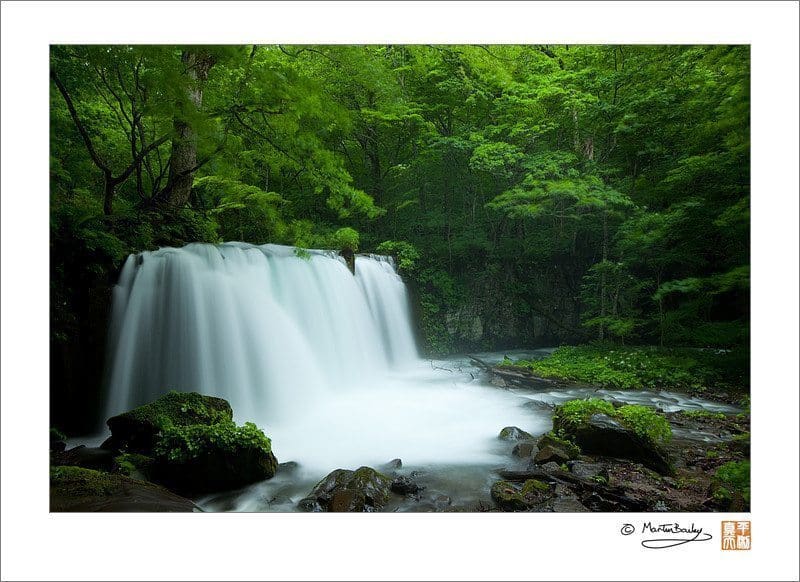
Oirase Choushi Ootaki (Big Falls)
There’s a bridge just down from the Big Falls is a small bridge, from which I shot image number 2304 (below). You can see a white patch in the top left of this image, which is the Big Falls through the trees. This part of the river is pretty wide, so I made that my main subject, but I paid attention to the two logs in the river on the right side. I shot this at F11 for 20 seconds, so the water is very dreamy, but the two logs luckily stayed very still, so they’re tack sharp. Another tip here, although a pretty obvious one, is that when shooting from small bridges like this, people walking on the bridge will usually cause enough vibration to cause camera shake. For long exposures like this from a bridge, you not only have to make sure that you wait until no one is walking on the bridge, but you have to stop very still yourself.
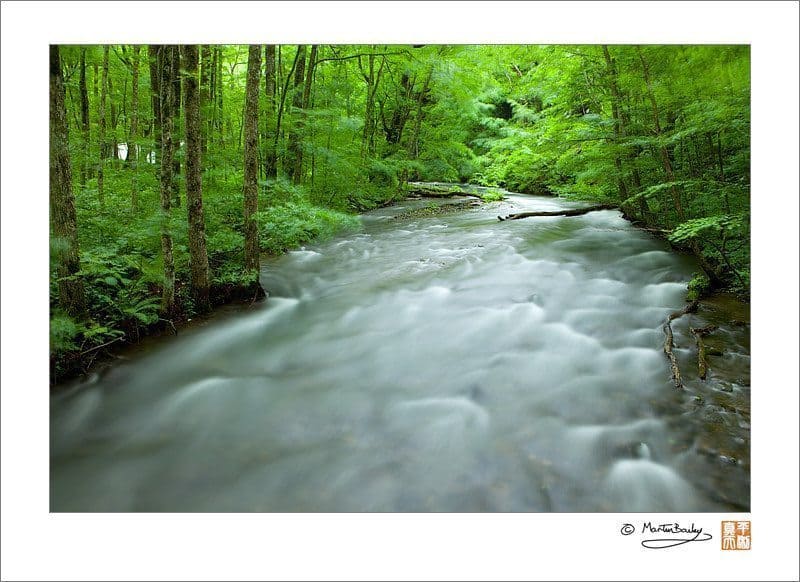
Oirase Mountain Stream
Next up is image number 2307 (below). Again shot at F11 for 20 seconds, I’ve really played on the moving leaves for this dreamy effect. It might not be for everyone but I personally really like this. I also shot this spot with my Lensbaby Composer, which made for an interesting image, but I’m going to save that shot for a later Podcast, as well as some of the others that I used the Composer for on the trip. I will put a link into the show notes though to view all 26 images from these two days, if you want a sneak preview.
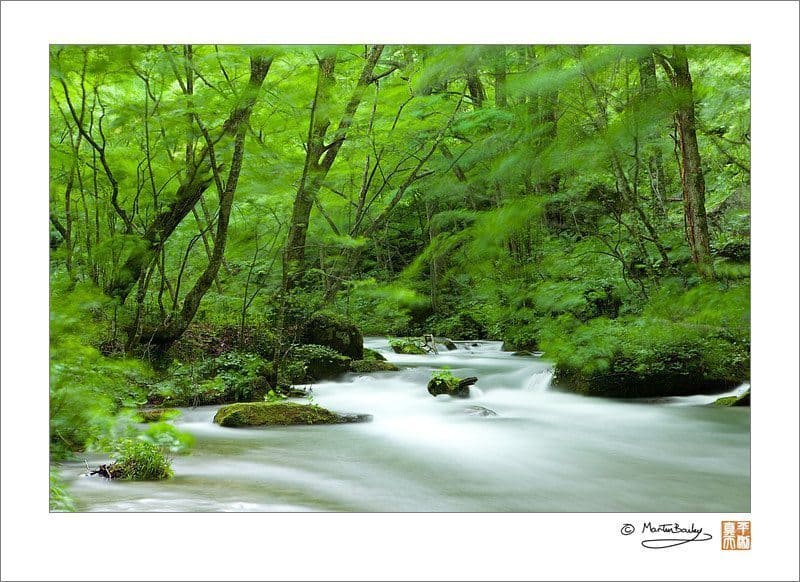
Oirase Mountain Stream
Look up! It’s easy to get caught in the trap of looking for similar shots in a location like this, but I do still try to look up into the canopy to see if there are interesting shots there. Shot number 2308 (below) is an example of what you’d miss otherwise. Here I noticed a tree that was split into two from the base, and looked up to see if it was worth photographing and I think it was. I was tempted to drop the 14mm wide angle lens on the camera, but went with the 24-70mm F2.8 at 25mm. Had I gone wider I’ve have lost detail in those wonderful round leaves that we see on the right side of the frame, which I think add a lot here. Notice too that this is one of those times when I allow some highlights to blow out. The histogram for this shot showed that there was a lot of overexposure in the image, but I ignored it, knowing that it was the sky peeping trough the canopy, which I was happy with. You have to be careful that the over-exposure doesn’t bleed into the detail of your subject too much, but just a little like this can actually add to the overall feel in my opinion. This was shot at F14 for 1 second by the way. I did wait for the leaves to stop blowing around here, apart from one small patch.
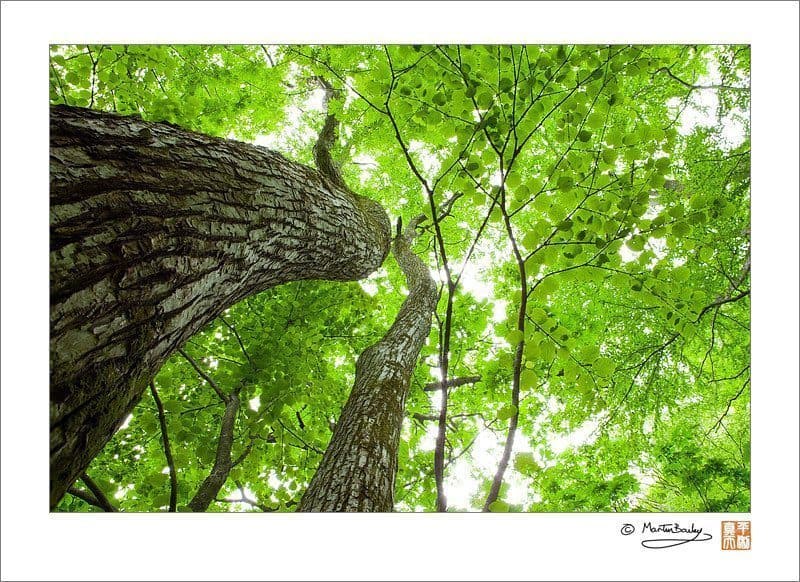
Big Tree and Fresh Leaves
Look Down! You need to look down from time to time as well, especially if you are into macro work, because there are also details around you, like the canopy, that you’ll miss if you aren’t looking for it. In image number 2309 (below), you can see that I found a little mushroom growing out of a fallen tree’s bark, so set my tripod up at the edge of the wooden boardwalk that winds through the woods at the side of the mountain stream. This was shot at F4.5 for 1/6 of a second at ISO 100. I stopped down to F4.5 to ensure that I got most of the mushroom in focus, but I didn’t want a deeper depth-of-field because I wanted to throw those green lines of moss out of focus, and I also like to see the cross section of sharp log showing how much DoF we actually do have. It just adds that dreamy look to the image overall, which I really like.

Mushroom on Fallen Tree
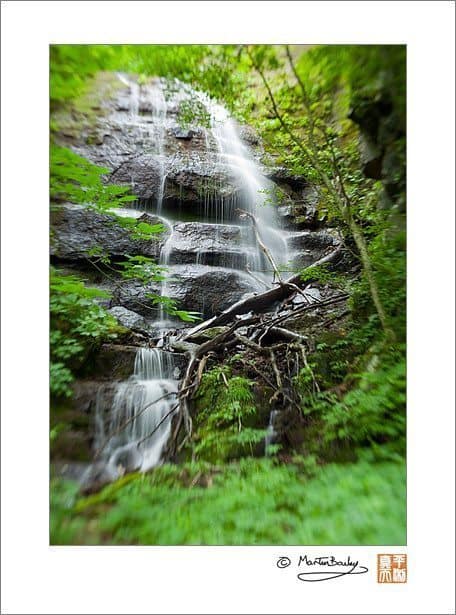
Kudan (Nine Steps) Falls
I actually shot image number 2311 (right) with the Lensbaby Composer, but I’m not going to talk about the Composer itself today, as again, I’m saving that for a future episode. I did want to mention though that there are waterfalls all through the valley, some of which are large and grandiose like the Choushi Ootaki that we looked at earlier, but others are much smaller, like the Kudan Falls. Kudan literally just means nine steps, like stairs, which we can see in the rocks behind the falls themselves. I will just say that I didn’t think there was a shot here, had I shot these falls straight. The Lensbaby Composer though helped me to make an image that I quite like, adding that nice soft outer ring of bokeh.
Finally, image number 2315 (below) is the shot that I mentioned earlier where the sun had come out. I had to wait for a while for the sun to get a little weaker, but this is as weak as it got for a while. Other shots while I waited had the water way too bright, and the trees got really dark trying to expose for the highlights. The result here though is that we have some shadows from the trees on the water, and the colour of the water is more golden. Also the trees have lots more shades of green, so I quite like this as well. By the way, it was the three little islands that drew me to the shot, but notice that I had placed the small island in the foreground in the bottom third intersection and composed the rest of the shot around that. I also like the way the thicker tree on the right runs up the right third line from the right-most island. Again too there is a static log sticking out of the water in front of that right island, which along with the few other rocks etc. make some nice anchor points in the flowing water, so it’s a nice balanced image overall.
The placement of objects like this, that we can’t control the actual position of, is governed of course by where we stand and of course how much of the scene we include depends on the focal length of the lens we select or zoom to. You’ll notice that some of the shots today are from higher vantage points than others. Here there was a footpath that I can get down to, but I chose to shoot this image from the side of the road. The images directly before this in the gallery were of the same scene, but shot from further down the river looking up at these islands with my tripod set up with one foot on each of three rocks in the river. My point here is that it’s important to explore various angles, vantage points and focal lengths to make the most of your location. Don’t forget to look up and down as well, for those added scenes that might not be too obvious without really looking for them.
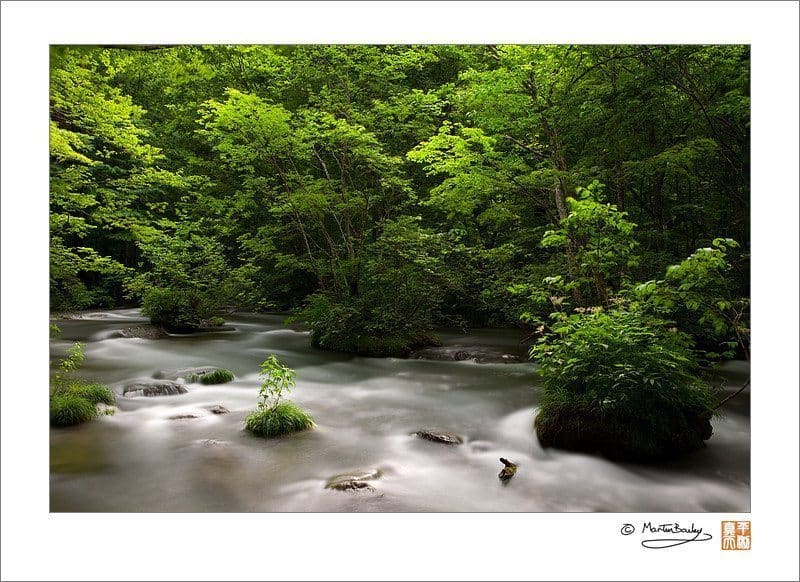
Oirase Mountain Stream
Podcast show-notes
This episode is sponsored by WebSpy, the Internet Monitoring, Analysis & Reporting Specialists.
The music in this Podcast was created and produced by UniqueTracks.
Audio
Subscribe in iTunes for Enhanced Podcasts delivered automatically to your computer.
Download this Podcast in MP3 format (Audio Only).
Download this Podcast in Enhanced Podcast M4A format. This requires Apple iTunes or Quicktime to view/listen.


Congrats on number 200! Great job, keep it up, you’re an inspiration!
… Q
Thanks Quintin!